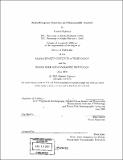Mark-recapture statistics and demographic analysis
Author(s)
Fujiwara, Masami, 1970-
DownloadFull printable version (8.268Mb)
Other Contributors
Woods Hole Oceanographic Institution.
Advisor
Hal Caswell.
Terms of use
Metadata
Show full item recordAbstract
Mark-recapture analysis of populations is becoming an important tool in population biology. Mark-recapture methods can be used to estimate transition probabilities among life-stages from capture histories of marked individuals for which stages can be determined at each sampling occasion. This method is called a multi-stage mark-recapture (MSMR) method. In this thesis, I describe advances I made in the MSMR method and present analyses that apply this method to actual data. The advances I made in the MSMR method are motivated by a need to provide a link between mark-recapture data and demographic models such as matrix population models and integrodifference models. I resolve some issues that are commonly encountered during sampling, such as the fact that the sex or life-stage of some individuals is unknown during some sampling occasions and that individuals become unobservable during some life-stages. I introduce a stage-structure that permits simple conversion of estimated transition probabilities into a matrix population model. I describe an algorithm to simplify programming for parameter estimation. I also introduce a method to estimate the distribution of dispersal displacements (a dispersal kernel) from mark-recapture data. I apply some of the methods described above to data of the North Atlantic right whale (Eubalaena glacialis). The right whales are considered one of the most endangered mammals. The current population size is about 300 in the northwestern Atlantic, and the number is declining. I applied the multi-stage mark-recapture statistics to the 17-year in- dividual sighting history data. (cont.) Using the estimated transition probabilities, I constructed a population projection matrix, which was used for further demographic analyses. I found that the population was slowly increasing in 1980, but it started to decline slowly around 1992. I show that (1) this change was caused by increased mortality of females that have just given birth, (2) protecting two females a year from the deaths is enough to prevent the declining trend, and (3) demographic stochasticity is a more important factor influencing their long-term viability than environmental stochasticity.
Description
Thesis (Ph.D.)--Joint Program in Oceanography/Applied Ocean Science and Engineering (Massachusetts Institute of Technology, Dept. of Biology, and the Woods Hole Oceanographic Institution), 2002. Includes bibliographical references (p. 130-138).
Date issued
2002Department
Joint Program in Oceanography/Applied Ocean Science and Engineering; Woods Hole Oceanographic Institution; Massachusetts Institute of Technology. Department of Biology; Massachusetts Institute of Technology. Department of Ocean EngineeringPublisher
Massachusetts Institute of Technology
Keywords
/Woods Hole Oceanographic Institution. Joint Program in Oceanography/Applied Ocean Science and Engineering., Biology., Woods Hole Oceanographic Institution.